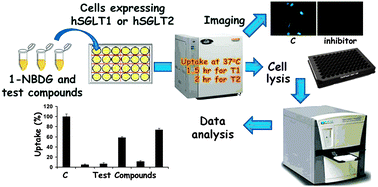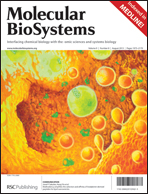Development of a novel non-radioactive cell-based method for the screening of SGLT1 and SGLT2 inhibitors using 1-NBDG†
Abstract
Sodium-coupled glucose co-transporters SGLT1 and SGLT2 play important roles in intestinal absorption and renal reabsorption of glucose, respectively. Blocking SGLT2 is a novel mechanism for lowering the blood glucose level by inhibiting renal glucose reabsorption and selective SGLT2 inhibitors are under development for treatment of type 2 diabetes. Furthermore, it has been reported that perturbation of SGLT1 is associated with cardiomyopathy and cancer. Therefore, both SGLT1 and SGLT2 are potential therapeutic targets. Here we report the development of a non-radioactive cell-based method for the screening of SGLT inhibitors using COS-7 cells transiently expressing human SGLT1 (hSGLT1), CHO-K1 cells stably expressing human SGLT2 (hSGLT2), and a novel fluorescent D-glucose analogue 1-NBDG as a substrate. Our data indicate that 1-NBDG can be a good replacement for the currently used isotope-labeled SGLT substrate, 14C-AMG. The Michaelis constant of 1-NBDG transport (0.55 mM) is similar to that of D-glucose (0.51 mM) and AMG (0.40 mM) transport through hSGLT1. The IC50 values of a SGLT inhibitor phlorizin for hSGLT1 obtained using 1-NBDG and 14C-AMG were identical (0.11 μM) in our cell-based system. The IC50 values of dapagliflozin, a well-known selective SGLT2 inhibitor, for hSGLT2 and hSGLT1 determined using 1-NBDG were 1.86 nM and 880 nM, respectively, which are comparable to the published results obtained using 14C-AMG. Compared to 14C-AMG, the use of 1-NBDG is cost-effective, convenient and potentially more sensitive. Taken together, a non-radioactive system using 1-NBDG has been validated as a rapid and reliable method for the screening of SGLT1 and SGLT2 inhibitors.


 Please wait while we load your content...
Please wait while we load your content...